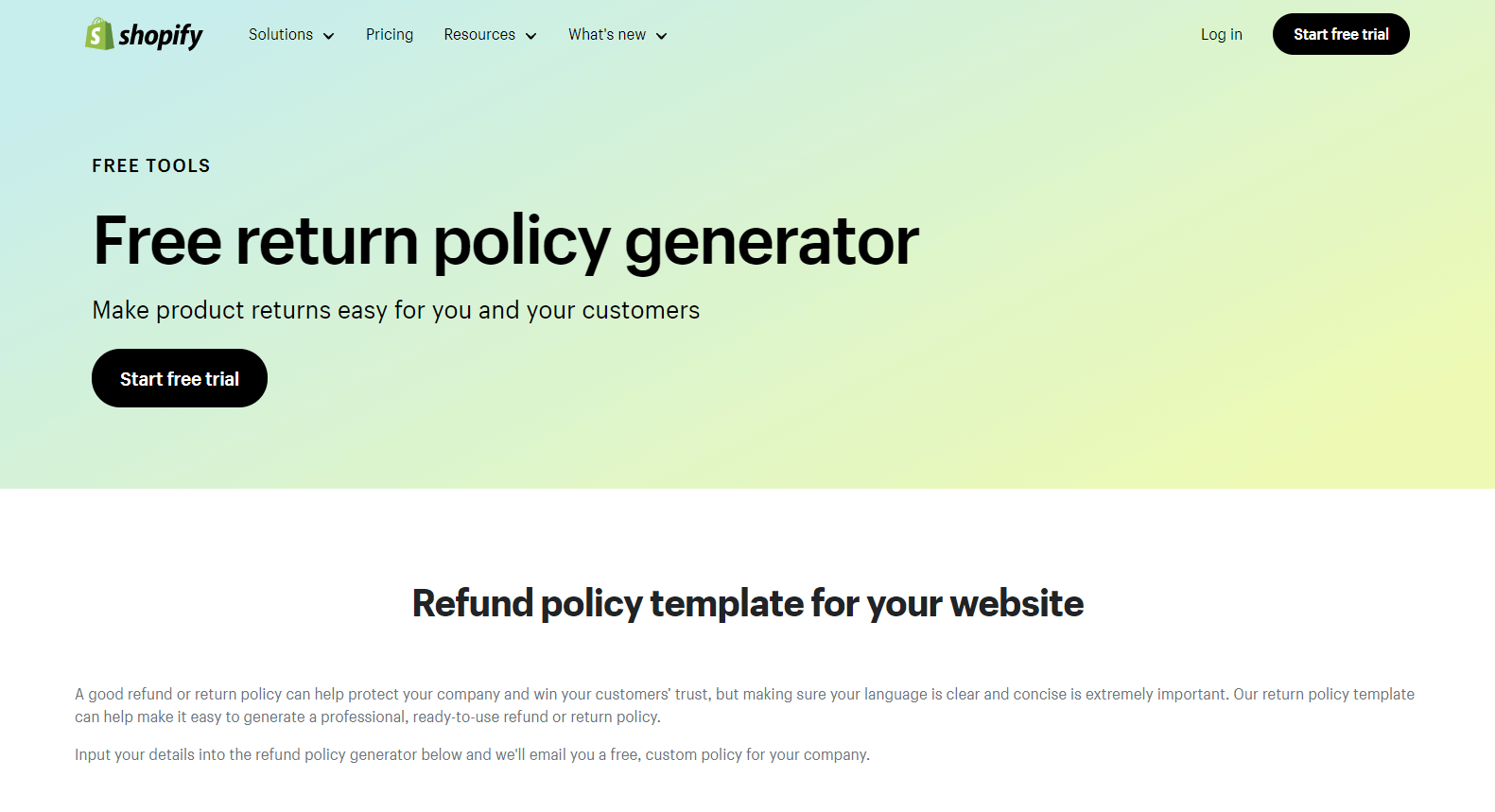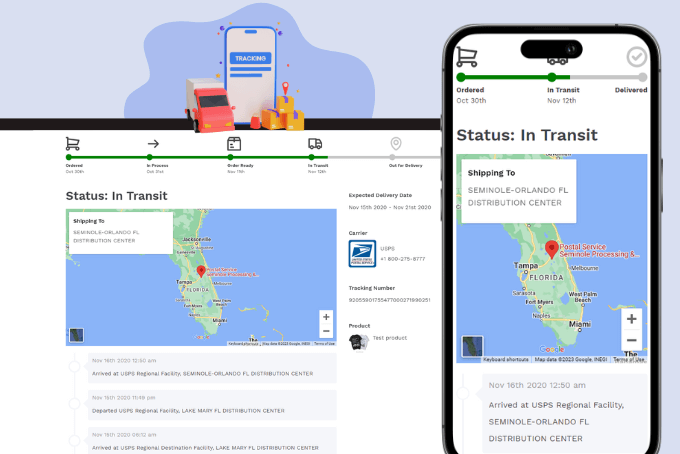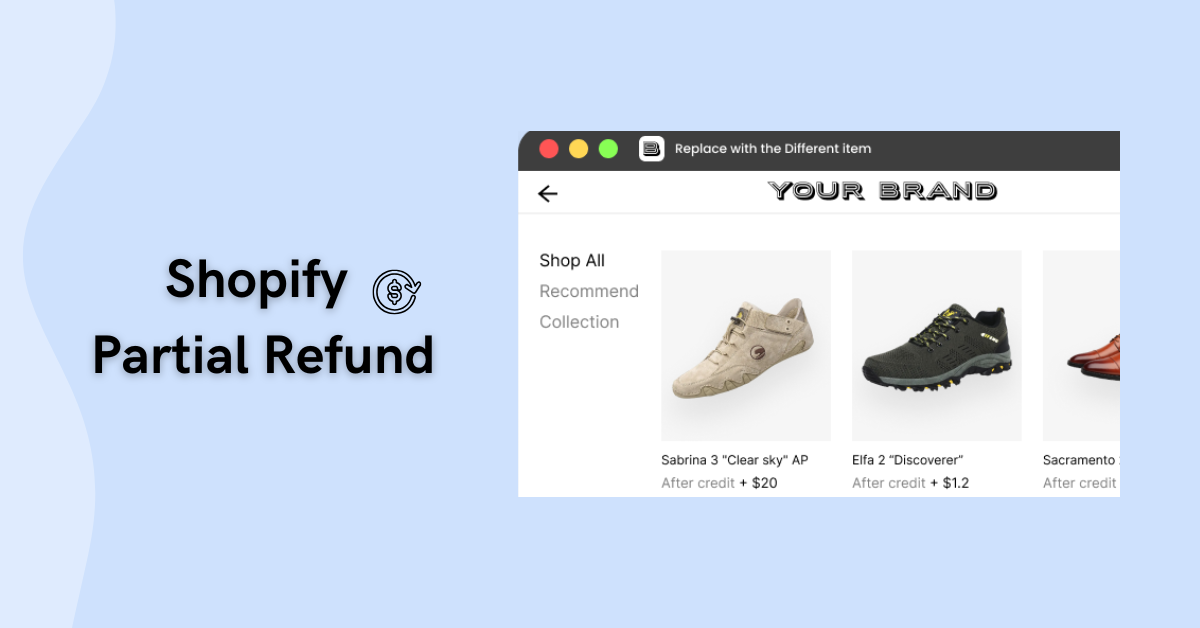
A return policy is a set of rules and procedures that guide a customer on the steps to take when returning an item. It serves as a framework for transparent transactions and trust building. Studies show that 49% of online shoppers check a store’s return policy before ordering, and 76% of first-time buyers admit they will buy again from a retailer if they have a smooth returns experience (SimiCart).
Running an online store without a return policy breeds mistrust and exposes you to fraud. This guide will enlighten you on the considerations before you start writing a returns policy, outline the essential components, and provide a step-by-step guide for drafting an effective return policy. Shopify merchants will also learn how to add a store return policy. This guide will wrap up with a look into how ParcelPanel can help you implement a comprehensive return policy.
What Should You Do Before Writing a Return Policy?
Crafting a return policy may seem complicated for someone who has not done it before, but it is easy once you understand what goes into one. The list below highlights the considerations you should make before writing your brand’s return policy.
1. Research Your Competitors
It is highly likely that your competitors already have a return policy in place. While you ought not to copy what your competitors are doing with regard to managing customer returns and related concerns, studying their return policy is a great start.
Researching your competitors gives you a clue about some common issues that customers in your niche face. Armed with this information, you can get insight into how to write an effective return policy for your online brand, address the pertinent questions you noted in your competitors’ policies, and gain a competitive advantage.
2. Find Some Return Policy Templates
Templates work like magic when you are coming up with a return policy. More than just speeding up the writing process, they help you know the most important clauses to include in the policy to make it effective for your business. Getting industry-specific templates is the hack here. For example, if you operate a clothing store, look for clothing return policy templates, as it will ensure you do not go off track with yours.
With a return policy template, you can save on exorbitant charges involved in hiring a technical writer to help you out. A thorough template allows you to work with an in-house writer to develop the policy without missing any important details or deviating from the main message.
3. Study Ecommerce Return Policy Examples
Successful eCommerce stores are your competition and your best case study examples when preparing to write a return policy for your brand. Studying the policies of the market leaders helps you glean some ideas on how to deal with common issues such as return timeframes, refund methods, and product conditions.
The most recommended approach is to visit the top ten eCommerce stores in your niche and thoroughly read their return policies to get an idea of how to craft yours. Established players can also give you insight on making the policy customer-centric so it yields positive results for your store when enforced.
4. Calculate Your Profit Margins
A clear return policy and smooth returns process boost customer satisfaction and enhance retention rates. However, it can be detrimental to your bottom line if not thought through. Therefore, before drafting a policy, assess your profit margins and forecast the potential impact of returns.
Consider shipping and restocking costs when drafting a small business return policy, as this will ensure you do not incur too many expenses that will eat into your profit margins. Looking at these margins also helps you decide beforehand if the customer needs to foot some of the costs involved in handling and processing the returns.
5. Develop Ways to Recover Lost Sales
When developing your return policy, it is best to be pragmatic rather than idealistic. Anticipate and mitigate the impact that returns will have on your sales and develop strategies to recoup value. This proactive approach is extremely useful when dealing with customers who are looking for how to make money returning items as they may be out to fleece your brand.
Consider clauses incentivizing exchanges, such as requiring customers to accept another product of the same value. You can also look for markets where you can sell refurbished items to retailers or direct consumers at a lower price. Charging customers restocking fees also eases your brand’s financial burden.
6. Check Local Laws and Regulations
Depending on where your online store operates, you will have different laws and regulations guiding how you approach customer returns. European countries and the UK require your store to have a return policy.
In the US, the law is different. A standard return policy is not a must, but without stating clearly that you have a no-return policy, you are liable to refund or exchange the purchase. If you can work with an attorney, this is the best option. But if not, check the state laws in the states that your online store ships to so as to avoid any legal run-ins.
8 Essentials of a Return Policy
Most guides on how to write a return policy will fail to mention this—no two return policies are the same. Each business will tailor its own to match the products it sells, the customers it serves, and other factors such as the cost of shipping. However, every return policy must have some essentials that a business can tailor to its needs. These basic elements are discussed below.
1. Return Window
Your return policy must clearly state the allowable time when returns are accepted. Most online businesses have a 30-day return policy, but you do not have to limit your customers to this timeline. It can be fewer or more days. Online stores with shorter return windows limit them to just 14 days. There are very few that go below that. On the higher side, eCommerce sites can allow a return window of up to 90 days. Experimenting with this to find the right balance for your brand is advisable.
A crucial element of the return window in any policy is when the period starts. For some businesses, this is immediately after the item is shipped, while others begin counting after the order is delivered. Still, for some, the return window starts when the item is invoiced.
2. Non-Returnable Items
Stating which items qualify for returns and which ones are excluded helps to improve transparency and keep the customers informed on what they can return if dissatisfied with the purchase for any reason. The standard return policy employed by many businesses states that some clothing items like underwear and swimsuits cannot be returned because of the intimate nature of these products.
You are also free to exclude promotional and sale items from returns. This clause ensures that during high-volume shopping periods like BFCM when most prices are slashed, there won’t be unprecedented returns.
3. Return Fees
As mentioned earlier, costs involved in reverse logistics can hurt your bottom line if not controlled closely. For this reason, it is crucial to explicitly state who covers the shipping costs and restocking fees likely to be incurred when a product is returned. Ensuring this clarity makes the customer understand who is responsible for the expenses involved, and therefore, they get to determine if a return is worth it.
Free returns shipping is a phenomenon slowly sweeping the eCommerce industry, but you do not have to join the bandwagon if your business cannot afford it. While free returns shipping can be a catalyst for increased sales, it is also likely to increase fraud cases where customers buy goods and then return them fraudulently (after use or damage) and claim a refund or exchange. Therefore, placing the burden of return fees on the customer helps deter fraud.
4. Return Methods
The return policy you write needs to define clearly how a product will be returned for a refund or exchange. Here, if you have a brick-and-mortar store, you can instruct customers nearby to return the product to it, whether bought in-store or online. The policy also needs to state whether a customer can use any carrier or needs to ship the return through a specific logistics service provider.
Sustainable businesses can tweak the “Return Methods” section of their return policy to align with their brand mission and vision. You can request that your customers only use specific green return methods, such as shipping via carbon-neutral carriers. Another option is to exclude return shipping and ask the customer to keep or donate the item.
5. Return Solutions
Return solutions refer to how you will resolve the return issue once a customer chooses to return the product. Refunds are the most common return solution customers expect, but these are not always feasible. It is, therefore, important to explore partial refunds when writing a return policy for small businesses and identifying full refunds as not feasible. These are also costly but can be issued after recouping shipping costs and restocking fees.
Other more affordable return solutions that strike a balance between keeping customers satisfied and saving costs are exchanges. Typically, the customer can get a replacement in a different size or color. You may also allow the customer to exchange their product for another item of similar value in your online store. Store credits will enable the customer to get an item of a given value from your store in the future, while gift cards can be combined with future purchases to buy other goods.
6. Return Address
A big question customers ask when they read through a return policy is to which address they should send the returned product. You need to clearly state the mailing address where the item should be sent, failure to which customers may start raising questions about your company’s willingness to help them post-purchase.
If the item needs to be shipped to a third-party logistics (3PL) partner facility, you must clearly say so to avoid misunderstandings. It also helps to make the process more transparent if you avail alternative contact methods the customer can use to determine if the returned items reached the intended address.
7. Conditions for Approving Returns
You are free to set acceptable conditions for approving returns. Some conventions that eCommerce businesses use here include that the product must be undamaged for approval. Other websites will include the need for the original tags to be intact if a return is to be approved and the refund or exchange process begins.
Clothing and apparel brands are famous for return policies that only approve products the customers did not wear/wash. Other conditions for return approval may include the product being unopened and contained in the original packaging. Setting these conditions is also a significant deterrent to fraudsters wanting to exploit a return policy.
8. Request Submission Process
How do customers submit requests to return the items they buy on your website? When writing a return policy, this question should be embedded in your brain as it helps to exclude jokers from the process and leave it open to customers with genuine concern.
Outline the step-by-step process for submitting a return request and what needs to follow for the item to reach you or a fulfillment partner. It should also inform the customer about what happens in the background once a return is received and processed. An uncomplicated return request submission process is the wish of every customer. Sharing a detailed walkthrough in your policy helps them to trust your brand more.
How to Write a Return Policy in 6 Easy Steps
With the return policy essentials understood and all the considerations made, you can now write a return policy for small business use. Use the following steps to get through this process successfully.
1. Know Your Business and Return Process Well
The best return policy for your business can only be written from the deep knowledge and understanding of how it operates and its ideal return process. This step requires you to merge your business processes to returns and find an intersection point.
Returns is an inbound logistics function that must fit perfectly with the outbound logistics already in place. A good practice is to evaluate the essentials reviewed in the section above and summarize how your business approaches each. Do you offer refunds or prefer exchanges? Where should customers send the returned items? Will customers use prepaid labels or a carrier of choice to ship the return? What is the return window?
The answers to these questions are center pillars of your business’ return policy, so they should be thorough and crystal clear.
2. Use the Shopify Return Policy Generator
Shopify is one of the biggest sales channels for eCommerce brands today. The platform hosts several tools that streamline online selling and the post-purchase experience for customers. If you are present on this platform and would like to write your policy quickly, Shopify has an easy-to-use return policy generator with which you can create an effective set of rules.

Scroll down th page and fill in the fields in the return policy generator to give the company an idea of what it entails, and click “Send me my return policy” to get the result. With just that, your Shopify return policy is ready to add to your store.
3. Draft a Return Policy by Yourself
Writing your business return policy from scratch is another option worth exploring, especially if you know about crafting, editing, and formatting one. This option allows you to tailor the policy’s clauses to meet your business’s specific needs and provide a satisfactory after-purchase experience for your customers.
When drafting the return policy by yourself, it is essential to research what the specific laws in your state stipulate. This ensures that apart from delivering a smooth returns process for your customers, you also abide by the rules in your area of operation.
4. Proofread and Polish the Return Policy
Use grammar refinement tools such as Grammarly and QuillBot to refine the wording of your return policy and ensure no grammatical errors. Although these tools are great for editing misspellings and rephrasing sentences, reading aloud the policy you wrote can help you catch any awkward sentences and excessive jargon.
Focus on making the policy easy to read by using everyday language. Furthermore, format it so that it is easy to scan and can be understood easily by readers of all levels.
5. Hold a Meeting for a Final Review
Two heads are better than one, especially when going through the process of how to write a return policy. Once you finish the policy document, invite your team to review it and share their ideas, suggestions, and criticism. This scrutiny by a new set of eyes can help you catch mistakes you made or open your mind to better ways of expressing certain clauses in the policy.
A final review meeting is also an opportunity to know what your team thinks about your return solutions. Some team members can have better ideas for recouping value and ensuring customer retention and repurchase rates grow significantly.
6. Update in Due Time
The online business world is a dynamic space that requires consistent trend monitoring to ensure you stay ahead of the competitors. Continuously look for new return handling trends and changes made by your competitors to their return policies. Doing this lets you understand what they are doing right and areas where opportunities exist for your business.
Once each review is completed, audit the data emanating from returns and analyze the role of the return policy in the said results. This process helps you understand what you are doing right and areas where you can improve. Alongside data analysis, collect customer feedback on the return policy to know their opinions and where it should be updated.
How to Add a Return Policy on Shopify?
Selling on Shopify without a return policy is a less-than-ideal situation that turns away many would-be customers and curtails your store’s growth. You can turn this around by adding a return policy with the following steps.
1. Access your Shopify Admin, click “Settings,” then select “Policies.”
2. Locate the “Return rules” section and select the “Manage” option.
3. Navigate to the “Return window” and select how long you’d like customers to request a return once they’ve received their orders.
4. Move to the “Return shipping cost” and set a flat rate, or select how you would like to handle your store’s return shipping fees.
Optional
The following settings are optional but can help enhance the effectiveness of your return policy.
a) Select the “Charge restocking fee” option and set a percentage to have customers pay for the service.
b) Select products that are ineligible for returns as final sale items through the following:
-
- Navigate to the “Final sale item exceptions” section.
- Click “Browse” or search for collections or products individually.
- Proceed to select collections, products, or product variants and click “Done.”
5. Click “Save” to keep the changes.
6. Navigate to “Policies “and click the” Turn on “option under” Return Rules. “
Implement Return Policy with ParcelPanel
At ParcelPanel, our team consists of innovators and eCommerce experts who are consistently working to develop new solutions that will help streamline how you manage your online store. From experience, we understand how complex managing your Shopify store can be. That is why we developed the ParcelPanel Returns & Exchange app.
This app is designed to smoothen your store’s return policy implementation process. It has a 24/7 return portal for submitting requests and housing your store’s return policy. Customers can choose return solutions from the portal and monitor the return progress.
Other features of this app include a return window set-up section and the option to exclude non-returnable items with specific eligibility rules. You can also protect your shop from fraudulent returns with blocklists.
Customers want to know that they can trust you to deliver. With ParcelPanel’s Returns & Exchange app, you can quickly implement a return policy on Shopify to reassure customers that you care about their post-purchase experience and are here to serve them well.












![Top 10 Loop Returns Alternatives and Competitors [2025]](https://images.surferseo.art/355d37b8-6936-4be4-b677-f5314b151724.png)





















